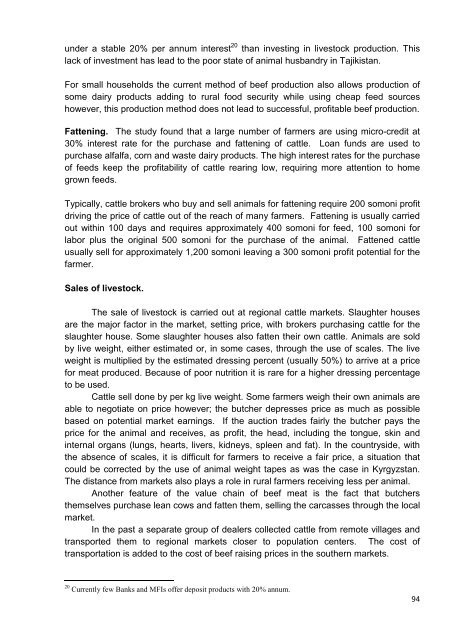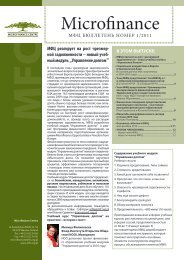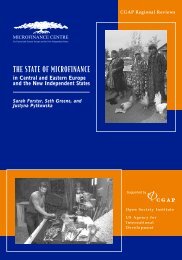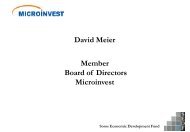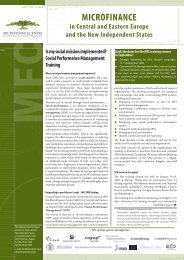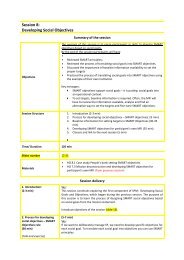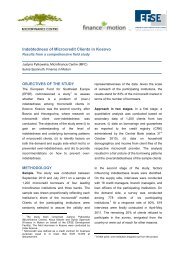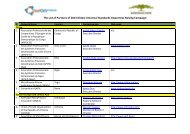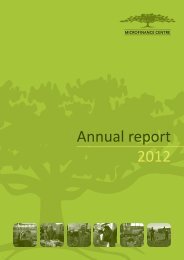Value Chains research report Tajikistan final - Microfinance Centre
Value Chains research report Tajikistan final - Microfinance Centre
Value Chains research report Tajikistan final - Microfinance Centre
You also want an ePaper? Increase the reach of your titles
YUMPU automatically turns print PDFs into web optimized ePapers that Google loves.
under a stable 20% per annum interest 20 than investing in livestock production. This<br />
lack of investment has lead to the poor state of animal husbandry in <strong>Tajikistan</strong>.<br />
For small households the current method of beef production also allows production of<br />
some dairy products adding to rural food security while using cheap feed sources<br />
however, this production method does not lead to successful, profitable beef production.<br />
Fattening. The study found that a large number of farmers are using micro-credit at<br />
30% interest rate for the purchase and fattening of cattle. Loan funds are used to<br />
purchase alfalfa, corn and waste dairy products. The high interest rates for the purchase<br />
of feeds keep the profitability of cattle rearing low, requiring more attention to home<br />
grown feeds.<br />
Typically, cattle brokers who buy and sell animals for fattening require 200 somoni profit<br />
driving the price of cattle out of the reach of many farmers. Fattening is usually carried<br />
out within 100 days and requires approximately 400 somoni for feed, 100 somoni for<br />
labor plus the original 500 somoni for the purchase of the animal. Fattened cattle<br />
usually sell for approximately 1,200 somoni leaving a 300 somoni profit potential for the<br />
farmer.<br />
Sales of livestock.<br />
The sale of livestock is carried out at regional cattle markets. Slaughter houses<br />
are the major factor in the market, setting price, with brokers purchasing cattle for the<br />
slaughter house. Some slaughter houses also fatten their own cattle. Animals are sold<br />
by live weight, either estimated or, in some cases, through the use of scales. The live<br />
weight is multiplied by the estimated dressing percent (usually 50%) to arrive at a price<br />
for meat produced. Because of poor nutrition it is rare for a higher dressing percentage<br />
to be used.<br />
Cattle sell done by per kg live weight. Some farmers weigh their own animals are<br />
able to negotiate on price however; the butcher depresses price as much as possible<br />
based on potential market earnings. If the auction trades fairly the butcher pays the<br />
price for the animal and receives, as profit, the head, including the tongue, skin and<br />
internal organs (lungs, hearts, livers, kidneys, spleen and fat). In the countryside, with<br />
the absence of scales, it is difficult for farmers to receive a fair price, a situation that<br />
could be corrected by the use of animal weight tapes as was the case in Kyrgyzstan.<br />
The distance from markets also plays a role in rural farmers receiving less per animal.<br />
Another feature of the value chain of beef meat is the fact that butchers<br />
themselves purchase lean cows and fatten them, selling the carcasses through the local<br />
market.<br />
In the past a separate group of dealers collected cattle from remote villages and<br />
transported them to regional markets closer to population centers. The cost of<br />
transportation is added to the cost of beef raising prices in the southern markets.<br />
20 Currently few Banks and MFIs offer deposit products with 20% annum.<br />
94


